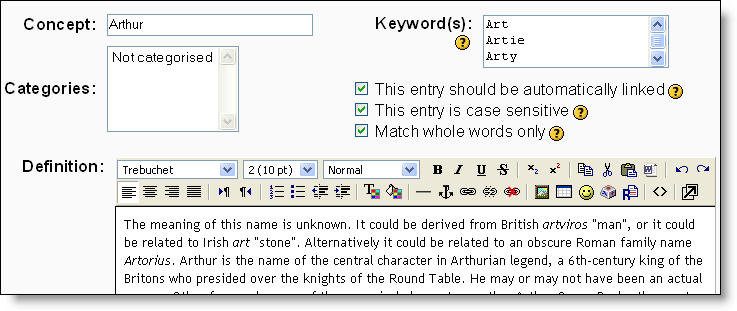Glossary settings
Adding a new entry, you have to fill in two fields. Others are obligatory.
Concept (mandatory)
Here you should insert the word/concept, the definition of which you wish to create.
Definition (mandatory)
As its name suggests, this field should contain the definition of the word/concept.
Keywords
Each entry in the glossary can have an associated list of keywords (or aliases). Enter each alias on a new line (not separated by commas). The aliased words and phrases can be used as alternative ways to refer to the entry. For example, if you are using the glossary auto-linking filter then the aliases will be used (as well as the main name of the entry) when deciding what words to link to this entry.
Categories
The default setting is 'Not categorised'. However, if you do add new categories, they will display here giving the possibility of choice.
Enabling automatic linking in a entry
Turning this feature on will allow the entry to be automatically linked, whenever the concept words and phrases appear throughout the rest of the same course. This includes forum postings, internal resources, week summaries and so on.
If you do not want particular text to be linked (in a forum posting, say) then you should add <nolink> and </nolink> tags around the text.
To be able to turn on this feature, auto linking must be enabled at glossary level.
Case sensitive matching
This setting specifies whether matching exact upper and lower case is necessary when performing automatic linking to these entries.
For example, if this is turned on, then a word like "html" in a forum posting will NOT be linked to a glossary entry called "HTML".
Whole words matching
If automatic linking is enabled, then turning this setting on will force only whole words to be linked.
For example, a glossary entry named "construct" will not create a link inside the word "constructivism".
